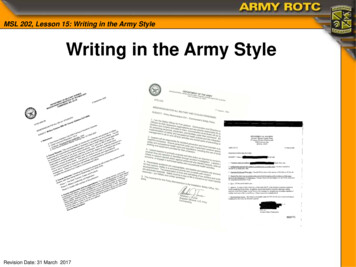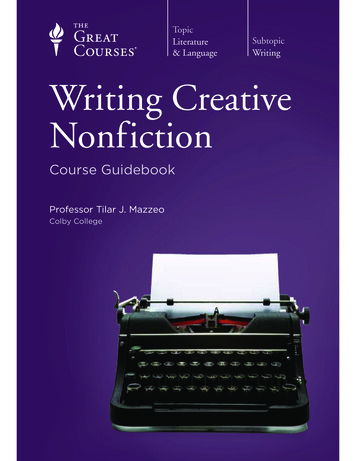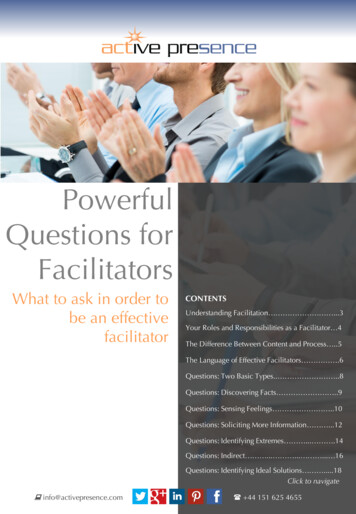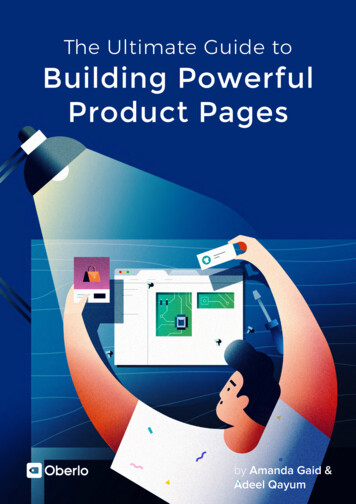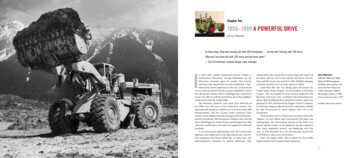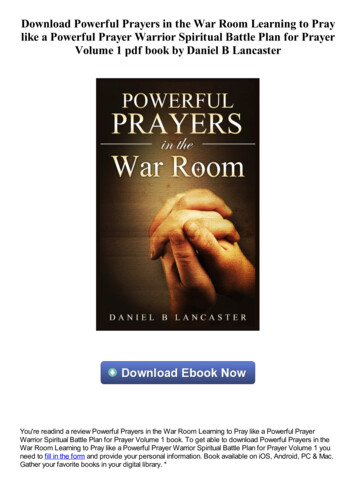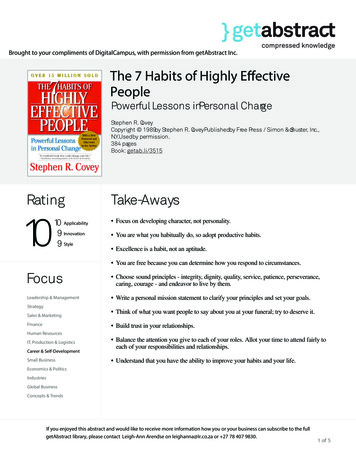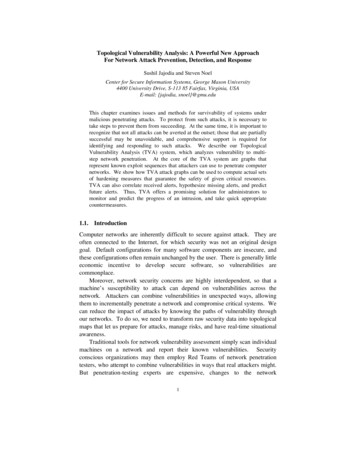
Transcription
PowerfulBusinessWritingPRESENTED BYNATIONAL SEMINARSGROUP, A DIVISION OFROCKHURST UNIVERSITYCONTINUING EDUCATIONCENTER, INC.S O M E T H I N GN E WT O D A Y 2005 Rockhurst University Continuing Education Center, Inc. Print 08/05 5023330a COM1A Presentation forAmerican Public Works Association
For information on this course and others, please contactValerie FrancisSenior Training ConsultantRockhurst University Continuing Education Center, Inc.National Seminars Group & Padgett-Thompson800-344-4613 ext. 3009vlfrancis@natsem.com
Success skills today are fast paced, ever changing and built on individual initiative.Tips to increase your learning: Identify your training goals and clarify what you need to learn. Meet fellow attendees and begin constructing a support network. Browse the resource library to continue your learning.Some people thrive in formal learning situations. Others prefer a self-directed approach such aslistening to audio programs, viewing videos or interacting with CDs and manuals.Whatever your learning style, the benefits you receive will be unequivocal if you focus on thefollowing ideas: Use all your senses as you train. Get involved, discuss issues and use the workbook as a tool.The workbook is your agenda, reference guide, review source and note-taking device.Accelerate your learning by using it to trigger ideas, provide follow-up and extend the training.Learning never stops for highly effective individuals. Knowing how to learn is whatdifferentiates levels of excellence.Skills Needed for 21st Century Thinking Taking charge when you are not in charge Gaining acceptance for your plan of action Building “webs” Replacing authority with information Managing ideas, not resources Becoming comfortable creating change Being perceptive: “seeing the patterns” Balancing imagination and logicThis training provides you with continuing education credit from Rockhurst University Continuing EducationCenter, Inc. If you are a licensed professional who needs special documentation or would like information aboutour other credit seminars and self-study programs, call our Continuing Education Specialist at 1-800-258-7246.
Workshop AgendaTurn Ideas Into Writing: Tips for Getting Started Quickly . . . . . . . . . . . . . . . . . . . . . . . . . . .2Make Sure Your Message Is Clear and Your Writing Is Error-Free . . . . . . . . . . . . . . . . . . . . . .6Use Contemporary Writing Techniques and an Inviting Tone toStimulate Reader Interest . . . . . . . . . . . . . . . . . . . . . . . . . . . . . . . . . . . . . . . . . . . . . . . . .11Conveying Professionalism and Credibility in Your Writing . . . . . . . . . . . . . . . . . . . . . . . .13Writing Letters, Memos and Reports That Are Organized and Reader-Focused . . . . . . . . . .15How to Influence, Persuade and Sell! . . . . . . . . . . . . . . . . . . . . . . . . . . . . . . . . . . . . . . . . .24Practical Solutions to Real-World Writing Challenges . . . . . . . . . . . . . . . . . . . . . . . . . . . .28Suggested Resources . . . . . . . . . . . . . . . . . . . . . . . . . . . . . . . . . . . . . . . . . . . . . . . . . . . . .32COM1040204
Turn Ideas Into Writing: Tipsfor Getting Started QuicklyAssess your writing comfort level and expertise.February 3, 2004Ms. Jane Smith, Vice-PresdentAcme Plumbing Co.86772 West MonroeChicago, Illinois 46892-302Dear Ms. Smith;Upon receipt of you’re letter dated, December 7, 2003, I put in the mail to you some upto-date information about our line of waterless products.I’m’ sure you have receive it by thistime.Irregardless of your background with waterless appilances, I think you will find this newproduct meets the needs of your customers. It’s most popular features are listed in the brochure.We have been up to our elbows I new orders.I would like for you to think about the possibility of handling this product. A Order form isis attached for you to order you prototype. We hope to hear from you so soon.Very truly yours:Mr. William BowenPresidentStrategic Industries, IncEnclosureCOM10402042
Turn Ideas Into Writing: Tips forGetting Started Quickly, continuedAnswering Three Key Questions Can CutYour Writing Time 30 to 40 Percent1.2.3.Five Simple Ways to Plan and Organize Eventhe Most Complex Writing Tasks1. Define your purpose for writing.2. Brainstorm and cluster.3. Freeform write.4. Revise, edit, format.5. Proofread.Step 1. Define Your Purpose for WritingCOM10402043
Turn Ideas Into Writing: Tips forGetting Started Quickly, continuedStep 2. Brainstorm and ClusterClustering ideas is an essential preliminary step for the writer to gain clarity about what he orshe intends to say. The process of stating the ideas and concepts and organizing them alerts thewriter to sloppy thinking, redundancies, lack of specificity, weak arguments and contradictions.Other Uses of Clusters: Solving problems. Planning projects. Appraising performances. Making “to-do” lists. Clarifying goals. Outlining a major report or proposal. Preparing for a complex phone call. Studying. Cluster textbook sections as you read them instead of “highlighting.” Put thepage number of the text at the bottom of a cluster page. Keep clusters in order in anotebook. Study for tests from clusters. If unsure of what a particular cluster means, reviewthat section of the text. That’s the only part of the book you have to read a second time. Preparing for confrontation. Make clusters of emotional issues and responses beforebeginning this difficult conversation. Taking notes. Jot down ideas that come to mind as others are talking. You’ll better retainwhat you want to say when it’s your turn to talk. Generating group ideas. This is good way to elicit contributions from the most hesitant ofteam members. It is also a good way to get candid input, since it can be doneanonymously, and it allows ideas to be judged on their own merit instead of by whocontributed them.COM10402044
Turn Ideas Into Writing: Tips forGetting Started Quickly, continuedStep 3. Freeform Write Turn off the interior editor. Set a time limit and write as fast as you can without stopping. Don’t worry about spelling, punctuation, grammar or style. If you can’t think of a sentence, write a sentence fragment or a list of words. If you run out of things to say, write the same sentence over again until something occursto you.Step 4. Revise, Edit, FormatExpect to do a draft or two!Step 5. ProofreadProofreading is a technical skill that will develop with practice.COM10402045
Make Sure Your Message Is Clearand Your Writing Is Error-FreeSix Questions Every Piece of Writing Should Answer1. Who:2. What:3. Why:4. Where:5. When:6. How:Commonly Confused Word Pairs andGroupings You’ll Never Mix Up AgainFind a full list on page 16 in your reference guide Business Grammar & Usage.AAnAn article used before a singular word with a consonant sound: We will spend amonth in Vermont and a week in Maine.An article used before a singular word with a vowel sound: She ate an apple andan orange.AcceptExceptTo take, agree: I accept the offer.To exclude, omit: It’s OK, except for this.AffectEffectTo influence or produce change in: The new policy does not affect our job situation.To bring about a result, cause: The president will effect many changes.AssureEnsureInsureTo declare confidently: I assure you everything is all right.To make sure or certain: To ensure quick payment, file your taxes now.To protect against risk or loss with insurance: I need to insure my car.COM10402046
Make Sure Your Message Is Clear andYour Writing Is Error-Free, continuedBetweenAmongUsed when speaking of two: Just between you and me, I don’t agree. There wereno secrets between Jane and John.Used when speaking of more than two: He was among a prestigious group ofthree who were honored at the ceremony.CiteSiteSightRefer to: He cited new sales figures.Location: The new building site is in Dallas.Scene: The skyline was a beautiful sight.CompriseTo include, contain: The whole comprises parts. The country comprised severalrepublics and states.To make up: The whole is composed of parts. The country is composed of severalrepublics and states.ComposeExplicitImplicitClearly expressed: The rules are explicit and cover every situation.Implied: The implicit manner she used left me guessing.FartherA greater actual distance: The journey to Tokyo was farther than the previous tripto Taiwan.To a greater degree or extent: This move will further our sales impact on thewestern states.FurtherFewerLessRefers to physical numbers of items: He ordered fewer magazines this year.Refers to matters of degree or value: It was less important to her than it was to him.The boy drank less milk than his sister.ImplyInferSuggest: I do not mean to imply that we move forward on this idea.Conclude, deduce: I inferred from the article that time management is key in allbusiness areas.ItsIt’sThe possessive form of it: The performance of its CEO will determine the outcome.A contraction of it is: It’s the nature of the business.LayLieTo put or place an object: He lays neatly folded newspapers on the tray.To recline: I lie in bed as I write this.ThatRefers to inanimate objects or animals without a name; used to introduce phrasesor words that must remain part of the sentence: The tree that died will be cutdown.Refers to animals without a name or inanimate objects; used to introduceparenthetical or explanatory phrases: I’m wearing my favorite dress, whichhappens to be blue.WhichCOM10402047
Make Sure Your Message Is Clear andYour Writing Is Error Free, continuedPresent Details Clearly and Explanations Simply Be specific. State your conclusion first. Use bulleted lists to make long, tedious details more readable. Avoid beginning sentences with “it is,” “there are,” etc. Highlight important points (sparingly).— Underscore— Bold face— Italics—Larger font sizes— ALL CAPS— Use white space intentionallyFour Simple Cures for the Most Common Sentence Ailments1.2.3.4.COM10402048
Make Sure Your Message Is Clear andYour Writing Is Error Free, continuedAvoid Errors Most Commonly Made in Letters and MemosUse These Six Surefire Ways to Eliminate Errors1. Use a spelling checker.2. Read backwards.3. Read out loud.4. Highlight as you move along if you’re working on-screen.5. Read hard copy line by line.6. Double-check by looking for these common errors: Run-on sentences and sentence fragments. Punctuation in general. Commas in particular. Quotations. Subject-verb agreement. Sentence length. Apostrophes. Capitalization. Spelling. Paragraphing. Omissions.COM10402049
Make Sure Your Message Is Clear andYour Writing Is Error Free, continuedShortcuts to Handling Grammar and Spelling ProblemsMake Good Grammar a Habit Conscientiously apply the rules of grammar to your conversation. Eliminate spokengrammatical errors and watch them disappear from your writing. Pay special attention to subject-verb agreement and pronoun usage, case (subjective andobjective), and number (singular and plural). Use words you know. Use a spell checker, but be aware of its limitations. Perform the daily exercises in your working reference Business Grammar & Usage.Quick References You’ll Want to Keep Close by Every Time You Write Check out the NPP handbook, The Essentials of Business Writing. The more you know,the more confidence you’ll have in your ability to communicate well. Use a spelling dictionary. Mark words you look up. If you look up the same word threetimes, put it on your spelling “hit list.” Use a hit list. Create a list of words you use often and that give you spelling headaches.List the words in alphabetical order, and keep it on your desk for easy reference. Taketwo or three words from the hit list and place them on an index card taped to yourcomputer. These words may become “sight words”; you will know on sight if they arespelled correctly. Use memory tricks. Mnemonic devices are helpful with certain words, e.g., in “desert”the “s” means sand; in “dessert” the double “s” stands for strawberry shortcake. Developa memory trick for every word on your hit list.COM104020410
Using Contemporary Writing Techniques andan Inviting Tone to Stimulate Reader InterestDo the Grammar Rules You Learned in School StillApply? Don’t Let the Myths Hold You Back!Revisiting Some Rules Never end a sentence with a preposition. Do not beginning a sentence with And or But. Never split an infinitive.Assessing Some Trends Use of contractions in business correspondence Use of short words, short sentences, short paragraphs and bulleted lists Use of gender-neutral nouns and pronounsHow to Use an Active Voice and a Conversational Toneto Enhance How Much Your Reader Will RememberWhat do active verbs do? They indicate immediate action. They are more emphatic. They indicate responsibility on the part of the writer.A Quick Tip for Active VerbsAlthough not always true, most passive verbs contain some form of the verb “to be.” Look for“was,” “were,” “have,” “has,” “have been” and “has been” in your writing. Whenever you findit, eliminate that form and use an active form of the verb. Avoid using “You have been late allweek.” Instead, try “You came in late all week.” Notice how action and responsibility areevident in the second sentence.COM104020411
Using Contemporary Writing Techniques and anInviting Tone to Stimulate Reader Interest, continuedWhen Is Jargon Appropriate?Jargon is only appropriate if it facilitates communication between two people who bothunderstand and use it.Cut Stiff, Outdated Lingo From Your Documents and ReplaceIt With Sharp Images That Enhance UnderstandingSkill PracticeRewrite the letter below to make it more effective business communication.Due to the fact that the item you requested in your recent letter of June 23rd has now beentemporarily discontinued, we are taking this opportunity to apprise you of this situation beforeyou begin the construction to which you alluded in said letter. Subsequent to your letter, ourcompany arrived at the conclusion that all such requests should be forwarded to ourengineering department, whose expertise in the field in which you are currently engaged wouldmake them the logical choice for further discussion and consulting as to the possibility ofsubstitute stock items, should such items be available. At your earliest convenience, may werequest that you be in correspondence with Mr. Norris regarding your particular needs? Pendingreceipt of your further correspondence, we will apprise Mr. Norris of your situation.COM104020412
Conveying Professionalism andCredibility in Your WritingWords That Are Never Appropriate in Business Writing You But Can’t Always or never Should have or ought to haveAlign Your Writing With the Image Your Organization Wantsto Project and Gain Recognition for Being a Business WriterWho Gets Results for Your Company1.2.3.4.5.How to Trim the Fat From All Your Business Documents“Keep It Short and Simple” and “Use Transitions” are quoted from Fat-Free Writing Business:Writing for the Information Age by Carol Andrus, Crisp Publications. Keep it short and simple. Write shorter sentences. Create must-read reference lines. Get to the point Close with a bang. Write shorter paragraphs. Use transitions.COM104020413
Conveying Professionalism andCredibility in Your Writing, continuedPurposeTransitionsTo add an ideaAlso, and, besides, furthermore, moreover, next, too, as well as,in addition, againTo summarizeIn brief, on the whole, in short, in sum, to sum upTo enumerateFirst, second, third, lastTo clarifyActually, in other words, clearlyTo illustrateFor instance, for example (e.g.), this is (i.e.)To compareAlso, similarly, likewise, as well asTo contrastAlthough, even though, but, however, on the contrary, on theother hand, yet, in contrastTo emphasizeCertainly, most of all, in fact, of course, in any eventTo make conditionalIf, unless, until, when, even thoughTo show cause and effectAs a result, so, therefore, consequently, accordinglyTo show resultsAs a result, therefore, so, henceTo reverse a thoughtBut, yet, on the contrary, regardless, neverthelessTo indicate time or sequenceFormerly, previously, meanwhile, before, after, until now, at thesame time, later, duringUse TransitionsWithout smooth transitions from one thought, section or idea to the next, the reader willexperience a bumpy road wondering where you are headed! Also tells the reader that you areadding a similar thought. However instantly conveys “Here comes something different.”Sentences and phrases can also serve as transitions: “That brings us to the next step, which is ” “Now that we’ve settled that problem, let’s look at ” “Unfortunately, in this case, we won’t be able to ” “In addition to budget constraints, there’s another matter we have to discuss.”COM104020414
Writing Letters, Memos and Reports ThatAre Organized and Reader-FocusedThree Characteristics All Good Business Letters Share1. They are short.2. They are clear.3. They are personal.How to Prepare Correspondence That Says “Professional” Appearance (letter style, placement on the page, font style and size) is the first indicationof a professionally written letter, memo or report. The second is no spelling or typographical errors. Third, the grammar is correct. Finally, professional correspondence is succinct, and its meaning is clear.Malcolm Forbes’ Advice on Writing Good Business Letters Know what you want; state it clearly. Call the person by name. Get it right! Be positive and natural. Tell your readers what’s in it for them. Give it your best effort. Make it look good — clear copy, centered and clean. Keep it short. Underline a couple of the most important words or phrases, but don’toverdo it. Maintain the reader’s interest. Don’t present opinions as facts. Make it correct. Errors leave your readers with only two possible reactions: The writer iseither ignorant or careless. Say what you have to say and get out.COM104020415
Writing Letters, Memos and Reports ThatAre Organized and Reader-Focused, continuedA Guide for Writing Any LetterWhat do all letters have in common? A beginning, middle and end. Review the beginning (B),middle (M) and end (E) of the following seven familiar types of correspondence.1. Information or acceptanceB: State the topic.M: Discuss or explain it.E: Say what you want done about it.2. Sales or persuasionB: Capture your reader’s attention with an idea or offer.M: Bombard the reader with convincing facts and emotional appeal.E: Urge the reader to act (or to agree) immediately.3. RequestB: Disclose what you want.M: Describe, when appropriate, why you want it.E: Thank your reader for the help you hope to get.4. ComplainB: Announce what’s wrong.M: Provide details enabling your reader to help.E: Say what you expect your reader to do next.5. RejectionB: Build a bridge of sympathy to your reader.M: Bury the rejection in the middle, justifying it while allowing the reader to save face.E: Emphasize anything good you can say about the situation.6. CollectionB: Courteously present the details of the overdue payment.M: Ask politely for immediate payment.E: Mention any action you plan if payment is not made immediately and enclose areturn envelope.7. GoodwillB: Express thanks, praise, congratulations or sympathy; extend an invitation.M: Support expression with personal details.E: End on a warm note.Adapted from Ellen Roddick, Writing That Means Business, Macmillan Publishing Co.COM104020416
Writing Letters, Memos and Reports ThatAre Organized and Reader-Focused, continuedOne Simple Technique That Will Make All YourWriting Easier to Read and More Powerful1. Eliminate errors: Learn to proofread.Proofreading Tips Scan. Read out loud. Read silently. Read backwards. Read slowly. Check proper names and little words. “Or” and “of”; “it” and “is”; and “for,” “form” and“from” are not interchangeable. Proof for one or two types of mistakes at a time (see list of common errors). Make a list of YOUR common errors and look for them specifically. Ask someone else to read the document. Proof headings separately and carefully. Look away (to a distant point) from the copy every few minutes to avoid eyestrain. Read down columns in a table. Avoid on-screen proofing. Read hard copy line by line. If you must proof on-screen, change font color and size. Use a different-colored pen to check off corrections made in the latest version. Work from enlarged text. Proof in four- to seven-word chunks.COM104020417
Writing Letters, Memos and Reports ThatAre Organized and Reader-Focused, continuedTips for an Effective Written Report or Proposal Highlight important points. Use bulleted lists for ease of readability. Number sequential steps. Leave plenty of white space. Make each paragraph eight lines or fewer.The Formal ReportReport formats vary from company to company. However, most long or formal reports have 11elements. Not every report will contain all 11 parts. You may want to omit some part, dependingon the kind of report and on your reader’s needs; nonetheless, you should be aware of thepurpose and function of each part.Preliminary Materials1. Title page — The title page contains all the identifying information. Title of the report Issuing company Recipients Date Writer’s nameMost companies have their own formats for title pages so check copies of previousreports to see which format your company uses.2. Letter of authorization — This letter follows a blank sheet of paper after the title pageand is formatted according to the company standard for business letters. The person whoauthorized the report should write the letter. It should outline the purpose of the materialand should authorize the research and writing of the report.3. Letter of transmittal — This letter, in the form of a regular business letter or memo,addresses the receiver of the report and explains the purpose of the report. It may containa checklist of all persons who will receive a copy of the report.4. Table of contents — The table of contents lists all the topics and materials in the report.Use lowercase Roman numerals to number all the preliminary report materials except thetitle page. Number the body of the report with Arabic numerals. Each company may havea slightly different format for the table of contents. Check previous reports to establish theformat. You may put the table of contents in uppercase and lowercase or in all caps. Youmay want to list the titles of appendices by letter. You will indent the appendix titlesunder the heading “Appendices.”COM104020418
Writing Letters, Memos and Reports That AreOrganized and Reader-Focused, continued5. Summary or abstract — Other terms you can use for this section of the report arepreface, synopsis, foreword or digest. This section gives the reader a quick, conciseoverview of the report. It is usually one-half page to one page long and does not includedata or figures.A good summary: Provides enough information to specify the aims and results of your project. Is brief without omitting essential information. Is written in a fluid, easy style. Is consistent in tone and emphasis with the body of the report. Makes use of accepted abbreviations to save space, but it does not include any tablesor illustrations.Body of the Report6. Introduction — The introduction describes the reason for the report. It contains thepurpose, methods of gathering data, sources, definitions and a brief plan of the report. Agood introduction arouses the reader’s interest and gives some background informationon the subject, preparing him or her for the contents of the report.7. Body — Include in this section all the pertinent data you have gathered and analyzed.State your case and substantiate your points, presenting the results of our research andanalysis. You may also include illustrations — charts, graphs, pictures — to support orenhance your discussion.Organize your report under various headings. Major headings indicate the main points ofthe report. Subheadings and sub-subheadings indicate subordinate and supporting ideas.You’ll notice that this use of headings is similar to the traditional outline that you learned tomake in your early grammar classes. Where you place the various categories and headingswill depend on your company’s preference, but, in general, follow these guidelines: First category — centered, in capitals Second category — left margin, in capitals Third category — left margin, initial capitals, underscored Fourth category — indented five spaces from left margin, initial capitals, underscored Fifth category — left margin, initial capitalsGenerally, you’ll need only three categories; however, you can use additional headingsif necessary.COM104020419
Writing Letters, Memos and Reports That AreOrganized and Reader-Focused, continuedHere is a general outline of where to put the various elements on the page: Page numbers — Number second and succeeding pages either at the top center ortop right-hand side, four lines from the top of the page. Alternatively, you may placepage numbers at the bottom center or right-hand side, approximately four lines fromthe bottom of the page. Major heading — center and capitalize Subheading — left margin, capitalize Margins — left margin, 1 1/2 inches; right margin, 1 inch; 1-inch to 1 1/2-inch topand bottom margins Body of report — double-space Long quotes — single-space long quotes, end footnotes, tables and bibliographies8. Conclusion — Readers may skim through the body of the report to get to the conclusionsection. They want to know what the data and supportive materials mean. What patterns,trends or observations did you find in your research? You should state your conclusionsbriefly and clearly, preferably in a series of numbered statements. Make sure that yourconclusions are logical outcomes of your data, supported by the information andresearch you have completed.9. Recommendations — Take your conclusions to the next step and answer suchquestions as: What should be done? How do we achieve the desired outcome? How can we persuade people to agree with our plan of action?Your recommendations should be action steps or suggestions for action that give thereader a starting point for the next phase in the process.Supplementary Materials10. Bibliography — List in the bibliography all sources used in writing your report. List thenames of people you’ve interviewed or with whom you have corresponded. Give thecomplete information on all books, reports, articles, documents and other references sothat your readers can locate and review these materials if they wish.Alphabetize entries in the bibliography by the author’s last name or by the document’stitle if there is no author. The articles and, a, and the are not used as the first word.11. Appendices — Include in this section information that supports the data in the body butis too lengthy or detailed to include in the text. You can include charts, questionnaires,short reports or documents, photographs, explanations of statistical methods or computerprograms used to gather data, transcripts of interviews or any other data you think thereader would find valuable.COM104020420
Writing Letters, Memos and Reports That AreOrganized and Reader-Focused, continued12. IllustrationsNote: Number illustrations consecutively within a chapter or throughout the report if you do nothave chapters. Give them a designation: Table 1 or Illustration 3. Graphs— Are visually more interesting that tables.— Allow the reader to easily spot trends, cycles and other movements.— Condense a large amount of material into a small space. Tables— Present information in columns.— Summarize changes or compare information over time.— Include more detailed or complex material than graphs.— Contain some narrative or explanation. Photographs— Are good when discussing site locations or new facilities.— Are excellent for showing damage for insurance purposes.COM104020421
Writing Letters, Memos and Reports That AreOrganized and Reader-Focused, continuedMemosMemos are less formal than business letters, but your recipients will expect your memos toadhere to the standard memo format, designed for quick and easy perusal of the contents.Header:DateTo (don’t include titles)From (initial next to your name prior to distribution)Subject (be very specific)Body:Your purpose for writingWhy it is important for your readerSuggested or recommended actionSample MemoMEMORANDUMDate:March 30, 2004To:All StaffFrom:Michael SmithSubject:New Parking PolicyEffective next Monday, April 2, the west parking lot will open at 7 a.m. and close at 9 p.m. Theadditional parking should more than compensate for closing the south lot during our expansion.Thanks for your flexibility during this exciting time.COM104020422
Writing Letters, Memos and Reports That AreOrganized and Reader-Focused, continuedCapitalize on Your Personal Style to Make Your Readers Comfortable Write the way you speak. Use words with punch. The short word is often the best word. Avoid unnecessary words.— Greatest maximum possible — maximum, most— Meet together — meet— With the exception of — except— Because of the fact that — because— The question as to whether — whether— Until such time as — until— Repeat the same — repeat Use personal words.— Compare “One’s job deserves one’s full attention” to “Your job deserves your fullattention.”— Compare “We request your attendance” to “We invite you to attend.” Use contractions.— Compare “I will call you tomorrow” to “I’ll call you tomorrow”; “We are redesigning”to “We’re redesigning.”— Most style authorities now agree that contractions are acceptable in modernbusiness writing.COM104020423
How to Influence, Persuade and Sell!Simple Ways to Add Impact to Every Sentence Use the recipient’s words and phrases. Use active voice rather than passive voice. Avoid beginning
Perform the daily exercises in your working reference Business Grammar & Usage. Quick References You’ll Want to Keep Close by Every Time You Write Check out the NPP handbook, The Essentials of Business Writing. The more you know, the more confidence you’ll have in your


